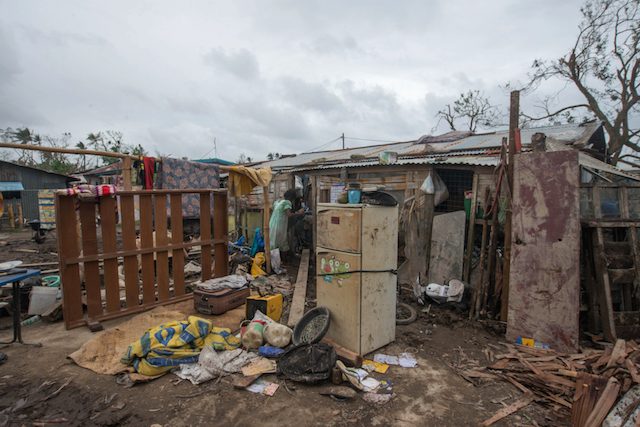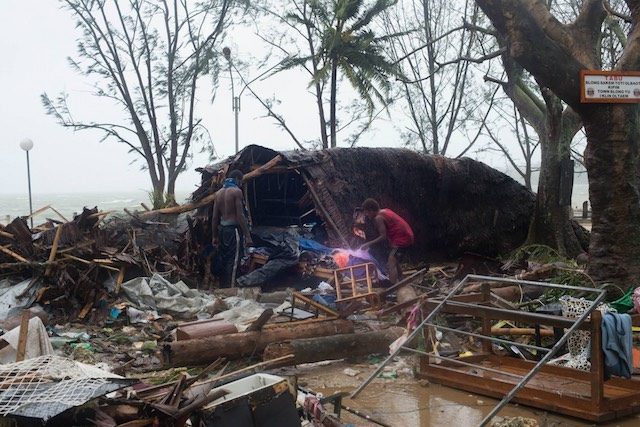SUMMARY
This is AI generated summarization, which may have errors. For context, always refer to the full article.

SUVA, Fiji (UPDATED) – Aid agencies Monday, March 16, described conditions in cyclone-ravaged Vanuatu as among the most challenging they have ever faced with fears of disease rife, as the Pacific nation’s president said climate change was partly to blame for the devastation.
Relief flights have begun arriving in the battered capital Port Vila after Super Tropical Cyclone Pam tore through on Friday night, March 13, packing wind gusts of up to 320 kilometers (200 miles) an hour.
But workers on the ground said there was no way to distribute desperately needed supplies across the archipelago’s 80 islands, warning it would take days to reach remote villages flattened by the monster storm.
Oxfam country director in Port Vila Colin Collett van Rooyen said a lack of enough clean water, temporary toilets, water purification tablets and hygiene kits needed to be addressed rapidly.
“Friday night was the first emergency with the arrival of Cyclone Pam, disease will be the second emergency without clean water, sanitation and hygiene provision,” he said.
“There are more than 100,000 people likely homeless, every school destroyed, full evacuation centers, damage to health facilities and the morgue.”
Save the Children’s Vanuatu director Tom Skirrow told Agence France-Presse the logistical challenges were even worse than for Super Typhoon Haiyan (Yolanda), which struck the Philippines in November 2013, leaving more than 7,350 people dead or missing and ravaging an area as big as Portugal.
“I was present for the Haiyan response and I would 100% tell you that this is a much more difficult logistical problem,” he said.
“The numbers are smaller but the percentage of the population that’s been affected is much bigger.”
Aurelia Balpe, head of the Pacific office of the International Federation of Red Cross and Red Crescent Societies, agreed that the task facing aid agencies was likely unprecedented in the region.
“I think for the Pacific, it’s probably going to be the biggest disaster we’ve ever implemented. I don’t think there has ever been destruction on this scale in one place,” she told Agence France-Presse.
The official death toll in Port Vila, where relief workers said up to 90 percent of homes have been damaged, stands at six with more than 30 injured, although aid workers believe this is likely a fraction of the fatalities caused by the storm.
Skirrow said 15,000 people were homeless in Port Vila alone and flights over remote islands in the archipelago, which spans more than 12,000 square kilometers (4,700 square miles), had confirmed widespread destruction elsewhere in the impoverished nation of 270,000.
“We’ve had aerial surveillance (of the outer islands)… all we can tell is what we suspected, that everything’s destroyed, but we don’t know what’s happening with the people right now,” he said.
He added that aid agencies were preparing supplies but it would likely be three days at least before airfields in remote islands were cleared.
Balpe said initial reports from two volunteers in the northern Torres and Banks islands were not as devastating, but no contact had been established with other areas and it appeared the southern island of Tanna had suffered widespread damage.
“He was very traumatized,” she said of a local Red Cross volunteer who was contacted on Tanna.
“He sounded like he was in shock and we couldn’t get very much information from him, just that there was devastation.”
Climate change ‘contributed’ to disaster

Pacific nations regard themselves as at the frontline of climate change, given many are low-lying islands dangerously exposed to rising sea levels, and Vanuatu President Baldwin Lonsdale said changing weather patterns were partly to blame for the destruction. (READ: As Vanuatu suffers, more urgency needed on climate – World Bank)
“Climate change is contributing to the disaster in Vanuatu,” the emotional leader said in comments carried on Australian television ahead of his departure from Japan, where he was attending a UN disaster meeting, to Sydney en-route to his homeland.
“This year we have had more (rain) than other years and for the last couple of weeks, the heavy rain has exceeded what has happened in the past.”
He termed the storm “a monster” and said he had not been able to confirm that his own family was safe.
Communications were still down across most of the islands, although the airport in Port Vila re-opened to commercial flights on Monday.
Military planes from Australia, New Zealand and France were arriving loaded full of food, shelter, medicine and generators, along with disaster relief teams.
The United Nations Office for the Coordination of Humanitarian Affairs said the cyclone, which was the maximum category five when it hit, had affected countries across the South Pacific.
“At least 9 nations have experienced some level of devastation including Vanuatu, Solomon Islands, Kiribati, Fiji, Tuvalu, and Papua New Guinea,” it said.
World leaders, including Australia, Britain, New Zealand and the European Union have pledged relief while IMF chief Christine Lagarde said the fund stood ready to assist. – Joshua Kuku, AFP / Rappler.com
Add a comment
How does this make you feel?
There are no comments yet. Add your comment to start the conversation.